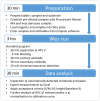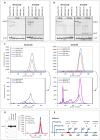Use of capillary Western immunoassay (Wes) for quantification of dystrophin levels in skeletal muscle of healthy controls and individuals with Becker and Duchenne muscular dystrophy
- PMID: 29641567
- PMCID: PMC5895072
- DOI: 10.1371/journal.pone.0195850
Use of capillary Western immunoassay (Wes) for quantification of dystrophin levels in skeletal muscle of healthy controls and individuals with Becker and Duchenne muscular dystrophy
Abstract
Duchenne muscular dystrophy (DMD) is a neuromuscular disease characterized by progressive weakness of the skeletal and cardiac muscles. This X-linked disorder is caused by open reading frame disrupting mutations in the DMD gene, resulting in strong reduction or complete absence of dystrophin protein. In order to use dystrophin as a supportive or even surrogate biomarker in clinical studies on investigational drugs aiming at correcting the primary cause of the disease, the ability to reliably quantify dystrophin expression in muscle biopsies of DMD patients pre- and post-treatment is essential. Here we demonstrate the application of the ProteinSimple capillary immunoassay (Wes) method, a gel- and blot-free method requiring less sample, antibody and time to run than conventional Western blot assay. We optimized dystrophin quantification by Wes using 2 different antibodies and found it to be highly sensitive, reproducible and quantitative over a large dynamic range. Using a healthy control muscle sample as a reference and α-actinin as a protein loading/muscle content control, a panel of skeletal muscle samples consisting of 31 healthy controls, 25 Becker Muscle dystrophy (BMD) and 17 DMD samples was subjected to Wes analysis. In healthy controls dystrophin levels varied 3 to 5-fold between the highest and lowest muscle samples, with the reference sample representing the average of all 31 samples. In BMD muscle samples dystrophin levels ranged from 10% to 90%, with an average of 33% of the healthy muscle average, while for the DMD samples the average dystrophin level was 1.3%, ranging from 0.7% to 7% of the healthy muscle average. In conclusion, Wes is a suitable, efficient and reliable method for quantification of dystrophin expression as a biomarker in DMD clinical drug development.
Conflict of interest statement
Figures








Similar articles
-
Low dystrophin variability between muscles and stable expression over time in Becker muscular dystrophy using capillary Western immunoassay.Sci Rep. 2021 Mar 15;11(1):5952. doi: 10.1038/s41598-021-84863-w. Sci Rep. 2021. PMID: 33723284 Free PMC article.
-
Contrasting Becker and Duchenne muscular dystrophy serum biomarker candidates by using data independent acquisition LC-MS/MS.Skelet Muscle. 2025 Jun 7;15(1):15. doi: 10.1186/s13395-025-00385-3. Skelet Muscle. 2025. PMID: 40483507 Free PMC article.
-
Development and Validation of a Western Blot Method to Quantify Mini-Dystrophin in Human Skeletal Muscle Biopsies.AAPS J. 2022 Dec 20;25(1):12. doi: 10.1208/s12248-022-00776-0. AAPS J. 2022. PMID: 36539515 Free PMC article.
-
Duchenne and Becker Muscular Dystrophies: A Review of Animal Models, Clinical End Points, and Biomarker Quantification.Toxicol Pathol. 2017 Oct;45(7):961-976. doi: 10.1177/0192623317734823. Epub 2017 Oct 3. Toxicol Pathol. 2017. PMID: 28974147 Free PMC article. Review.
-
[From gene to disease; the dystrophin gene involved in Duchenne and Becker muscular dystrophy].Ned Tijdschr Geneeskd. 2002 Feb 23;146(8):364-7. Ned Tijdschr Geneeskd. 2002. PMID: 11887623 Review. Dutch.
Cited by
-
TLR3 absence confers increased survival with improved macrophage activity against pneumonia.JCI Insight. 2019 Dec 5;4(23):e131195. doi: 10.1172/jci.insight.131195. JCI Insight. 2019. PMID: 31801911 Free PMC article.
-
Detailed genetic and functional analysis of the hDMDdel52/mdx mouse model.PLoS One. 2020 Dec 23;15(12):e0244215. doi: 10.1371/journal.pone.0244215. eCollection 2020. PLoS One. 2020. PMID: 33362201 Free PMC article.
-
Label-free proteomic analysis of Duchenne and Becker muscular dystrophy showed decreased sarcomere proteins and increased ubiquitination-related proteins.Sci Rep. 2025 Jan 26;15(1):3293. doi: 10.1038/s41598-025-87995-5. Sci Rep. 2025. PMID: 39865125 Free PMC article.
-
ACTA1 H40Y mutant iPSC-derived skeletal myocytes display mitochondrial defects in an in vitro model of nemaline myopathy.Exp Cell Res. 2023 Mar 15;424(2):113507. doi: 10.1016/j.yexcr.2023.113507. Epub 2023 Feb 14. Exp Cell Res. 2023. PMID: 36796746 Free PMC article.
-
Evaluation of Exon Skipping and Dystrophin Restoration in In Vitro Models of Duchenne Muscular Dystrophy.Methods Mol Biol. 2022;2434:217-233. doi: 10.1007/978-1-0716-2010-6_14. Methods Mol Biol. 2022. PMID: 35213020 Free PMC article.
References
-
- Emery A. Duchenne muscular dystrophy. 2nd ed Oxford, England: Oxford University Press; 1993.
-
- Ryder S, Leadley R, Armstrong N, Westwood M, de Kock S, Butt T, et al. The burden, epidemiology, costs and treatment for Duchenne muscular dystrophy: an evidence review. Orphanet J Rare Dis. 2017;12: 79 doi: 10.1186/s13023-017-0631-3 - DOI - PMC - PubMed
-
- Muntoni F, Torelli S, Ferlini A. Dystrophin and mutations: one gene, several proteins, multiple phenotypes. Lancet Neurol. 2003;2: 731–740. - PubMed
-
- Abbs S, Tuffery-Giraud S, Bakker E, Ferlini A, Sejersen T, Mueller C. Best practice guidelines on molecular diagnostics in Duchenne/Becker muscular dystrophies. Neuromuscul Disord. 2010;20: 422–427. doi: 10.1016/j.nmd.2010.04.005 - DOI - PubMed
-
- Allen D, Whitehead N, Froehner S. Absence of dystrophin disrupts skeletal muscle signaling: Roles of Ca2+, reactive oxygen spcies, and nitric oxide in the development of muscular dystrophy. Physiol Rev. 2016;96: 253–305. doi: 10.1152/physrev.00007.2015 - DOI - PMC - PubMed
Publication types
MeSH terms
Substances
LinkOut - more resources
Full Text Sources
Other Literature Sources

